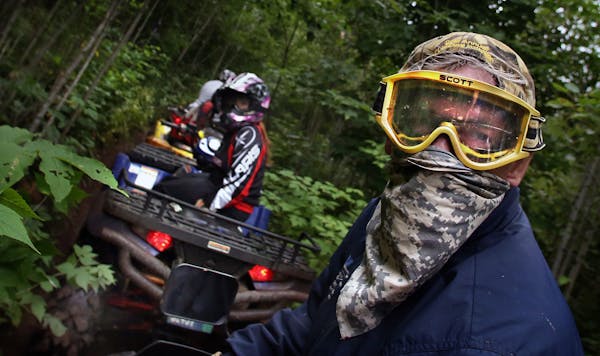Throughout his long teaching career at the University of Minnesota Duluth, Hollie Collins, a biology professor, held both a personal and professional interest in rainbow smelt.
"I used them in my springtime fisheries course," he said. "We'd do an age and growth study on them, and examine how the females are larger than the males, and smoother, too, and how the males during spawning season get tiny elevations on their skin, which they later slough off.
"Then, when our research was complete, the students and I would toss the smelt into a deep fryer and eat them."
Collins, 78 and retired, can be forgiven if he led his students astray from exacting scientific methodology by consuming the objects of his examinations.
Smelt, after all, provide excellent table fare, and throughout much of the past century, countless Minnesotans enjoyed the tiny fish — often to excess. More than that, smelt and smelting were, in combination, a long-running cultural phenomenon in this state.
Decades ago, during the smelt's heyday, Gov. Jesse Ventura, himself a cultural phenomenon, was among the thousands of Minnesotans who headed to the North Shore to dip long-handled nets into freezing rivers for smelt — and to party.
"It's the kind of trip where every waking moment you have a beer in your hand," Ventura once explained about his annual smelting ventures with childhood friends. "We drive up there with generators and stereos and tons of fireworks."
So plentiful were smelt at the beginning of World War II that the government studied ways they might be preserved and packaged for consumption by troops overseas.
Even as recently as the early 1970s, more than 1.5 million pounds of smelt were being caught in trap nets by Minnesota commercial harvesters. By the turn of the century, however, that same harvest had dwindled dramatically, with only 7,600 pounds taken in 2005.
"There are still smelt running," said Russ Francisco, owner of Marine General, a long-standing fishing, marine supply and water sports store in Duluth. "The runs aren't what they once were. But there are smelt being taken right now [in Duluth] by seiners along Park Point Beach."
Doubtless most Minnesota smelters who recall driving north in spring to dip conical nets into frigid rivers would, in a heartbeat, do so again if the fish's big runs returned.
And why not?
From the Lester River on the outskirts of Duluth, up the North Shore to the Knife, Steward, Baptism and other rivers, fun- and fish-seeking smelters congregated en masse at nightfall, warming themselves around campfires until someone yelled, "They're running!"
This occurred when water temperatures at stream mouths hovered around 40 degrees, signaling to smelt it was time to swim upriver, where they would remain over the winter before spawning the following spring.
Awaiting the 4-inch-long fish as they skedaddled upstream were countless wader-clad men, women, boys and girls, each bracing themselves against rapid-running springtime rivers while swinging dip nets full of smelt toward shore, where wash tubs, garbage cans and/or 5-gallon buckets waited to be filled.
"Our preference was the Lester River, and it was an absolute zoo," Collins said. "When the smelt came screaming in, in two or three scoops you'd have a 5-gallon bucket full."
Growing up in the Upper Peninsula of Michigan, I also remember big-time smelting. Along with my dad and brother, I'd wait until a friend of Dad phoned to say the run was on in the nearby Rapid River.
At the time, my brother, Dick, was fixing up a vintage Chevy pickup, and when word came that smelt were running, the three of us squeezed into its front seat, hoping the tie rods would hold and the engine wouldn't blow.
Awaiting us streamside was a scene right out of "Mad Max: Fury Road." Fires blazed in 55-gallon drums; acrid smoke from burning tires rose into a starry sky, and hilarity ensued when overserved smelters sloshed to shore in water-filled hip boots or waders.
Later, at home, with gallons of smelt at our sides and scissors in hand, we excised the heads of the small fish before eviscerating them. And repeating. Endlessly.
• • •
Though not widely acknowledged at the time, the smelt's rise to Great Lakes prominence was doomed to be relatively short-lived. The reason: smelt were an invasive species in the Great Lakes.
Intentionally planted in Crystal Lake, Mich., in 1912, smelt escaped into Lake Michigan and spread throughout the Great Lakes, appearing in Lake Superior in 1946.
Multiplying exponentially, their numbers peaked in Lake Superior in the 1960s and '70s as sea lamprey, another invader, decimated the lake's primary predator, lake trout. Not until a chemical was developed that proved effective in killing lamprey did trout numbers begin to recover.
About the same time, coho and chinook salmon, among other predator species favored by anglers, were introduced to Lake Superior. Their presence, along with resurgent lake trout numbers, contributed to the smelt's downfall.
"When smelt were abundant in Lake Superior, the lake essentially was in an unstable state," said Cory Goldsworthy, DNR Lake Superior area fisheries supervisor. "From a management perspective, we wouldn't want to see them come back they way they were. If they did, it would mean the lake would be out of balance again."
Last week at DNR headquarters in St. Paul, Goldsworthy and other DNR fisheries staff held the last of three public meetings to discuss a new Lake Superior fisheries management plan developed by the agency. The highly detailed plan envisions a bright future for Superior's game fish, including lake trout, steelhead and salmon.
But nowhere is it suggested that rainbow smelt will return to prominence in Lake Superior anytime soon. If ever.
Dennis Anderson • danderson@startribune.com

Anderson: Trailblazing sonar will be in thousands of boats for opener

Anderson: Celebrate Earth Day by rekindling real connection to nature
Anderson: Anglers protesting tough new Mille Lacs rules are wrong

Anderson: Courts, not politicians, should rule on Red Lake, White Earth lands


